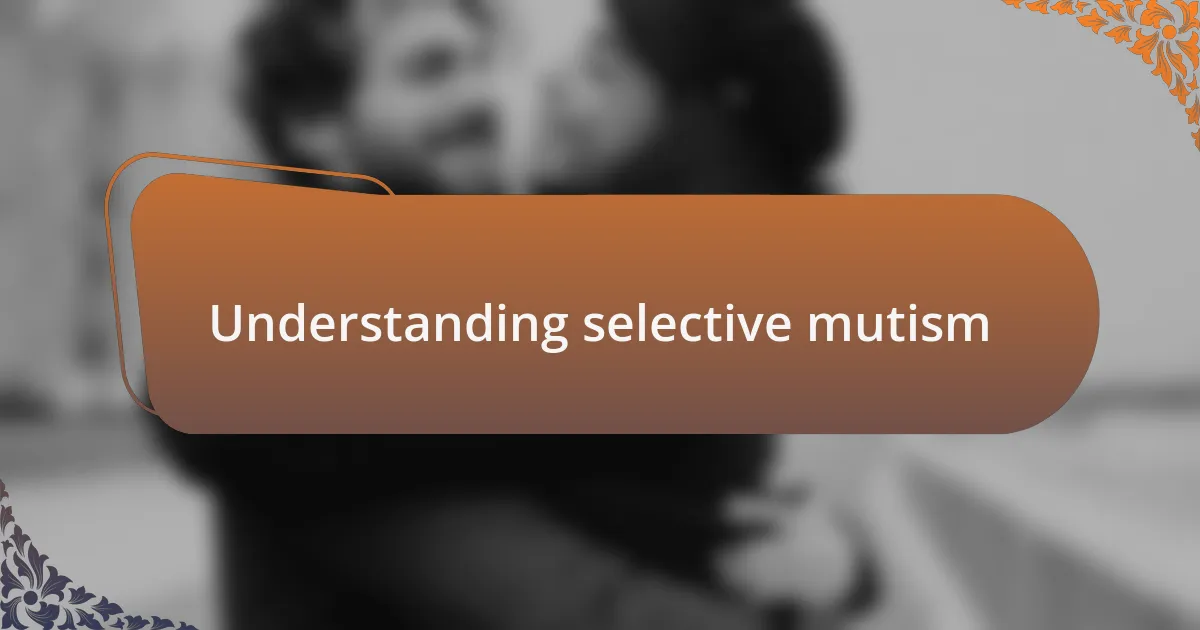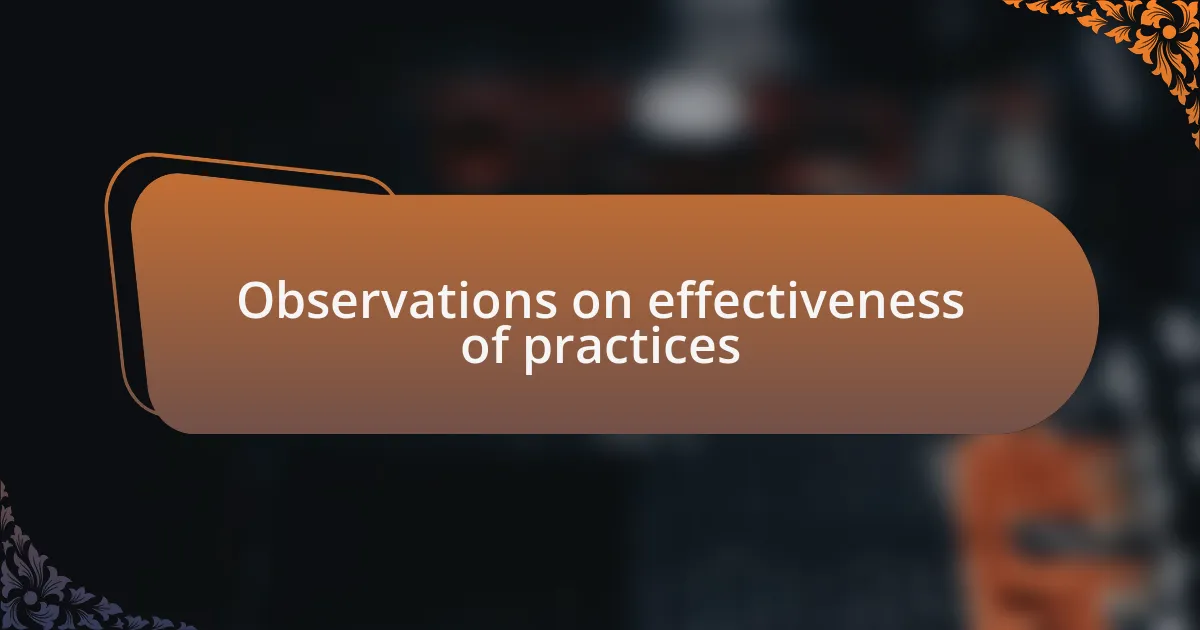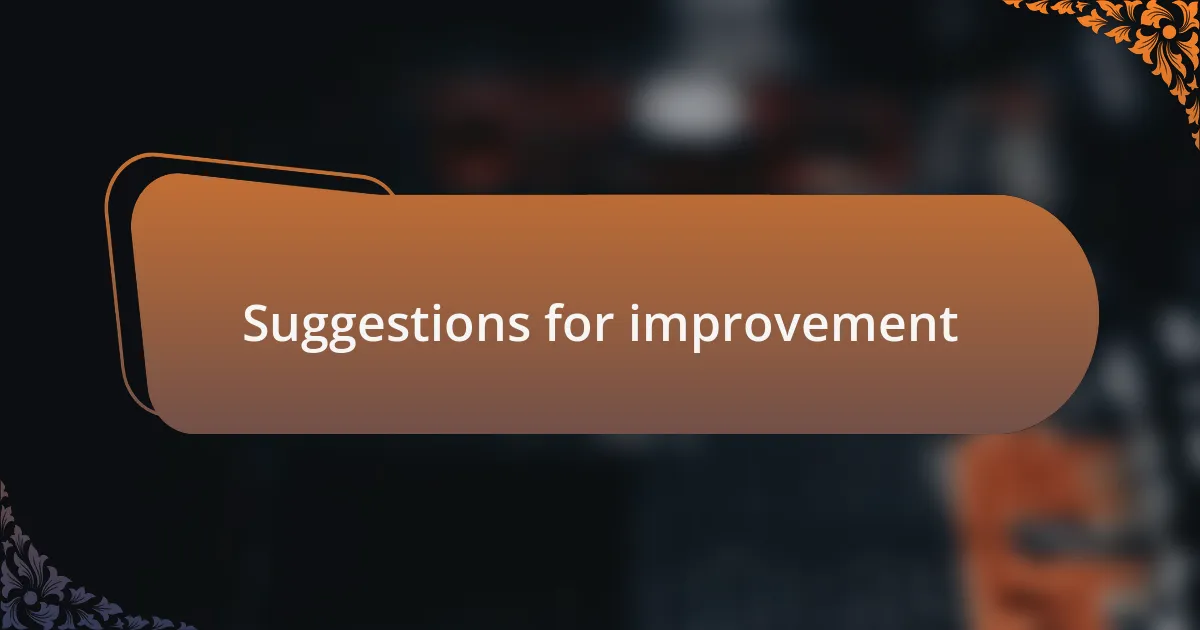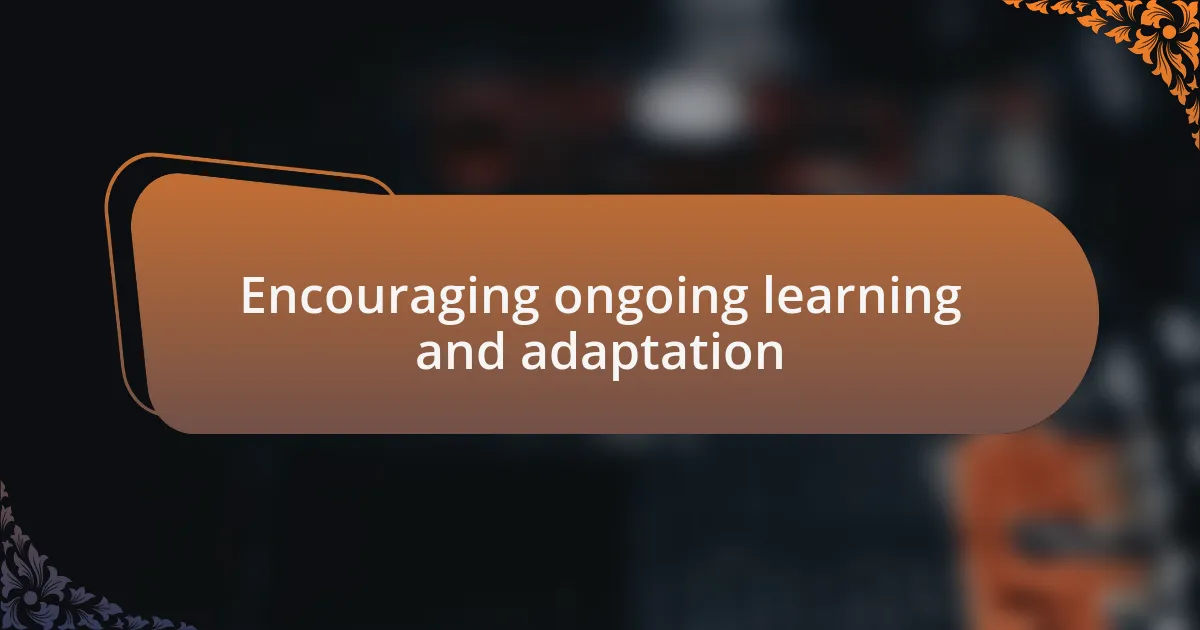Key takeaways:
- Selective mutism is a complex anxiety disorder that manifests as difficulty in speaking in specific social situations, contrasting with a child’s ability to communicate comfortably at home.
- Evidence-based practices, such as cognitive-behavioral therapy and gradual exposure techniques, are crucial for effective interventions and support for children with selective mutism.
- Creating safe environments and building a collaborative approach among parents and educators can significantly enhance a child’s confidence and communication skills.
- Ongoing professional development and adaptation in techniques are essential for caregivers and educators to effectively support children with selective mutism.

Understanding selective mutism
Selective mutism is more than just shyness; it’s a complex anxiety disorder that typically emerges in childhood, causing individuals to struggle with speaking in certain social situations despite being able to communicate comfortably in other environments. I recall my friend’s little brother, who would light up at home with his family but become mute during school hours. It was heartbreaking to witness his distress, especially when he wanted to raise his hand but couldn’t bring himself to speak.
This condition often leaves parents and educators puzzled, leading them to question why a child who seems so expressive at home can suddenly become silent around peers. From my experience, it’s important to understand that each child has their own triggers and comfort zones. I remember a seminar where a speaker emphasized that every child is unique and that empathy can go a long way in helping these children feel safe enough to express themselves.
Moreover, understanding selective mutism requires patience and awareness of the child’s internal struggle. I’ve seen how nurturing environments can help gradually coax a child out of their shell. Isn’t it essential for us to create safe spaces where children can grow and feel comfortable? It’s a reminder that communication is not just about words but about creating connections that foster trust and understanding.

Importance of evidence-based practices
Evidence-based practices play a crucial role in addressing selective mutism, as they rely on research and proven methods to inform interventions. I remember attending a workshop where a therapist shared success stories rooted in these practices. Hearing about real-life changes brought hope and validation to the struggles families face. Isn’t it inspiring to learn that there’s a solid foundation behind the strategies we choose to support these children?
In my experience, employing evidence-based methods ensures that we are not merely guessing what might work. For instance, incorporating gradual exposure techniques, which have been shown to help ease anxiety, can significantly alter a child’s experience in social settings. I think about the parents I’ve spoken with who tried various approaches without success. When they finally turned to guided, research-backed strategies, they felt empowered and found a renewed sense of purpose in their efforts.
Moreover, the importance of evidence-based practices extends beyond individual cases; they provide a standardized approach that can bring consistency across different settings, like home and school. I recall a situation where a teacher and a parent collaborated using evidence-based techniques, leading to remarkable progress for the child. Wouldn’t it be wonderful if every child with selective mutism could have access to the same effective strategies? By championing evidence-based approaches, we not only elevate the conversation around selective mutism but also pave the way for transformative experiences for these children.

Key evidence-based strategies
I have found that cognitive-behavioral therapy (CBT) is one of the most effective evidence-based strategies for addressing selective mutism. When I first learned about CBT, I was intrigued by its focus on changing thought patterns to alter behaviors. A child I once knew struggled to speak in specific settings, but after participating in CBT, their confidence gradually blossomed. Seeing this transformation firsthand reinforced my belief in utilizing structured therapies that have a solid foundation in research.
Another powerful strategy is the use of social stories. These narratives help children understand and navigate social situations, offering them a sense of predictability. I remember creating a social story for a young girl who felt overwhelmed at her school. The next time she faced her classmates, she was able to refer back to the story we crafted together. This not only provided her with tools to cope but also facilitated a sense of accomplishment. Have you ever noticed how a simple story can spark such courage?
Additionally, parent training programs that focus on reinforcing speaking in low-pressure environments have shown remarkable outcomes. I spoke with a mother who diligently applied these techniques during family gatherings. It was heartwarming to witness her child gradually speaking up when prompted. These strategies remind us that the journey towards overcoming selective mutism is a collaborative effort, where support from caregivers makes all the difference. How rewarding it is when families bond over these small victories!

Personal experiences with selective mutism
There was a moment in my life that truly encapsulates the essence of selective mutism. I remember attending a birthday party where I encountered a little boy who sat quietly in the corner, his eyes darting around, clearly wanting to join in but unable to find his voice. It made me reflect on my own childhood experiences of feeling trapped in silence, just like him. Watching him struggle stirred a deep empathy within me, reminding me that the journey to find one’s voice is often painful yet profound.
Another significant experience involved helping a girl named Lily, who would only whisper her thoughts at home. One day, during a quiet afternoon, we engaged in art therapy, drawing not just images but emotions. As she colored, I noticed her smile grow wider, and she began speaking about what she was creating. The joy of seeing her express herself, albeit tentatively, made me realize the power of gentle encouragement and the right environment in fostering communication.
Reflecting on these interactions, it becomes clear that each child’s path is uniquely personal. Have you ever noticed how subtle changes can have a colossal impact on overcoming selective mutism? When I see the gradual shifts in confidence within these children, it fills me with hope. Their stories remind me that patience and understanding are key components of this journey, and every small step forward can lead to meaningful breakthroughs.

Observations on effectiveness of practices
Observations on effectiveness of practices
When it comes to evidence-based practices for selective mutism, I’ve witnessed how strategies like gradual exposure can reshape a child’s experience. For instance, I recall facilitating a small group session where children took turns speaking in a safe, non-judgmental environment. The noticeable shift in their willingness to share was inspiring; it made me realize that creating a trusted space can significantly enhance their comfort levels.
In my experience, incorporating behavioral techniques, such as positive reinforcement, often yields remarkable results. One particular child I worked with thrived when praised for small verbal contributions. It made me think—how often do we underestimate the power of encouragement? I’ve observed that even a simple “great job” can ignite a spark of confidence in these children, motivating them to take further risks in communication.
Moreover, I’ve noted the value of family involvement in the process. During one session, a parent’s participation encouraged their child to vocalize feelings that had been bottled up for too long. This made me wonder: is there anything more powerful than building a bridge between home and therapeutic practice? The synergistic effect of supportive families and targeted strategies not only accelerates progress but also fosters a lasting sense of security.

Suggestions for improvement
Addressing the nuances of selective mutism requires a multifaceted approach. I often think about incorporating technology into our strategies. For example, I once introduced a speech app during a session, allowing a child to express themselves through a fun and interactive medium. This led me to ponder: Can digital tools offer a unique platform for self-expression that traditional methods might overlook?
Building upon the classroom environment is another vital suggestion. In my observations, fostering collaboration among teachers is crucial. During one workshop, I noticed how a unified approach among educators transformed the way children felt about speaking up. It reinforces the idea that when the entire community is aligned in understanding selective mutism, it creates a ripple effect that amplifies each child’s confidence.
Finally, I believe in the importance of targeted training for those working directly with these children. I remember attending a seminar focused on specific strategies, which reshaped my perspective entirely. This experience ignited my belief that professional development should be ongoing—are we doing enough to equip caregivers and teachers with the tools they need? Perhaps more comprehensive training could bridge gaps in understanding and ultimately lead to more effective interventions.

Encouraging ongoing learning and adaptation
Investing in ongoing learning is essential for those working with children who have selective mutism. I recall a time when a colleague shared her personal journey of learning about new techniques in a workshop. Hearing her describe how her newfound knowledge transformed her interactions with her students was incredibly inspiring. It made me wonder: what if every educator committed to continuous growth?
Adaptation is equally important, as every child is unique in their needs and responses. I once observed a therapist who amended her approach mid-session when she noticed a child’s discomfort. This flexibility allowed for a moment of genuine connection—one that might have been lost had she not adjusted her methods. Don’t we all know the power of being responsive and adaptable in fostering a safe environment for communication?
Finally, I believe the process of learning from our experiences can be a profound teacher. During my own practice, I maintain a reflective journal where I document successes and challenges. Looking back, I’ve discovered patterns that have informed my strategies moving forward. This practice begs the question: how can we encourage others in our field to embrace reflection as a path to innovation? The potential for transformation is remarkable when we commit to this journey of learning together.